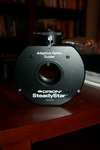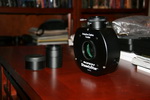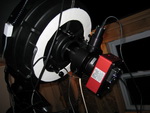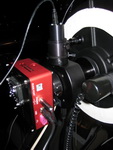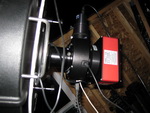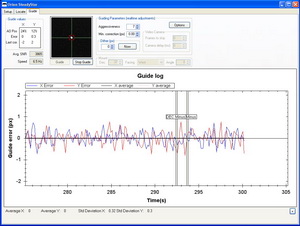Imaging Equipment - Adaptive Optics
Adaptive optics is a technology used in professional observatories to eliminate effects of seeing - it depends on changes of the shape of main mirror controlled by a computer guided usually by a laser beam creating "artificial star". Amateur astroimager has access to simplified units, that generate fast guiding corrections by inclining an optically flat glass positioned in the light path. Flat piece of glass will shift the image when inclining due to refraction effect, but the displacement cannot be too large, so the computer issues a regular guiding corrections from time to time. Three companies make such AO systems: SBIG (AO8, AO9), StarlightXpress (SXVF-AO) and Orion (SteadyStar).
I chose Orion SteadyStar, I had a good experience with other Orion products and SteadyStar was available immediately while a new version of SXVF-AO was still being developed (SBIG AO requires certain SBIG cameras). AO requires a sensitive guiding camera, so I bought StarlightXpress Lodestar. The first release of Orion SteadyStar software had problems deinterlacing Lodestar images, I reported it to them and they fixed it in a week. Very impressive customer service! I understand that problems happen, especially with new products, after all the same deinterlacing problem was also reported for MaximDL, and you can't check all the hardware combinations on real stars. It is how the problems are dealt with by the manufacturer what makes all the difference. Thumbs up for Orion! Make sure to download the newest version if SteadyStar software if you are going to use Lodestar with SteadyStar AO.
Orion SteadyStar OAG is well designed, the prism can be moved in and out, and the prism arm has T-thread adapter at the end - allowing guider light path to be as short as needed. The most flexible way to attach Lodestar is by using T-thread to 1.25 eyepiece holder adapter from ScopeStuff. Lodestar is all 1.25" barrel and it can be pushed down all the way in if needed, or moved out as necessary for focusing. Similarly as with TS OAG the prism cannot be rotated without rotating the entire unit, but it is typical for an AO OAG.
My first real image with Orion AO is
NGC5005. First, I
have updated SteadyStar software - Orion releases updates and
improvements often so it is a good idea to check it before each session.
Second, I had a nice chat with Orion representatives at NEAF 2010 (very
nice and helpful guys), they
explained to me in detail about Ao parameters and how to make the
best of them. The most important was to realize that the percentage of
movement (tilt) of the flat optical element is between -50% to 50%, so if I set the
unit to "bump" the mount at 45% mark it is way too large and could
result in a visible "bumps" in guiding. Optimal threshold is around 25%.
Another thing is to make sure the mount corrections are not too
big, you should not see a change in guiding after a mount correction is issued. They cannot
be too small either, i.e. optical element must be able to return easily
to a
below threshold tilt, if it can't, the corrections are too small and the guiding is
doomed in the long run. I am very happy with my
NGC5005 result (black
and white, only had time for 24 luminance frames). After
all the tuning up I was able to collect 24x5 min images with C14 at f8.8
with perfectly round stars. Moreover, if you look at the example of
guiding from this night (picture below), the span of deviations is +/-
0.8 pixel or 1.6 pixel total, with the Lodestar binned 2x2 on CGE1400 at
f8.8 it corresponds to a span of 2 arc seconds, which is a very good
result. Typical seeing at my site is around 2 arc seconds, so it likely
means the guiding was "seeing limited". Now it would be interesting to
further tune up the AO to eliminate some of the seeing blur
![]() ... As you can
see DEC corrections do not change the guiding accuracy.
... As you can
see DEC corrections do not change the guiding accuracy.
Since the final star size is the ultimate measure of guiding accuracy I measured the average star sizes on all NGC5005 subexposures and converted the results to arc seconds using the measured images scale (0.365 arc sec/pixel). The average half-flux diameter (HFD, or half-flux radius HFR) is between 1.40 arc sec and 1.55 arc sec (1.48 average), which corresponds to full width at half-maximum (FWHM) between 2.3 arc sec and 2.6 arc sec (2.47 average).
HFD is the diameter of a circle that contains half of the "brightness" flux of a star and it is a very good star size indicator which can also work egg-shaped stars. It widely used in autofocusing applications. FWHM is another star size measure that simply reports its diameter at half height of the maximum brightness (see exact definition here).
I have added RGB to NGC5005 , however I had only a part of a night to do it so, I had to keep colors low to avoid too much noise. The next image was M95, luminance only - it was done on the last clear night before the Moon came back, and then M95 was too far to the west. Since 2010 I have used Arion AO extensively and most high-resolution C14 images are made with it. Examples include M1, NGC2392, M27 and M51.
